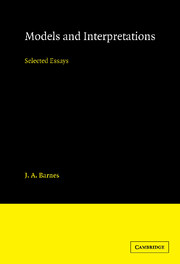Book contents
- Frontmatter
- Contents
- Preface
- Acknowledgments
- Introduction: social science in practice
- I MODELS OF THE REAL SOCIAL WORLD
- 1 Genetrix: genitor:: nature: culture? (1973g)
- 2 African models in the New Guinea highlands (1962a)
- 3 Agnatic taxonomies and stochastic variation (1971n)
- 4 Class and committees in a Norwegian island parish (1954a)
- 5 The righthand and lefthand kingdoms of God: a dilemma of Pietist politics (1971k)
- 6 Indigenous politics and colonial administration, with special reference to Australia (1960a)
- 7 The perception of history in a plural society: a study of an Ngoni group in Northern Rhodesia (1951c)
- II MODELS OF SOCIAL SCIENCE
- III A MODEL OF MODELLING
- Postscript: structural amnesia (1947: 52–3)
- Bibliography
- Index
3 - Agnatic taxonomies and stochastic variation (1971n)
Published online by Cambridge University Press: 08 January 2010
- Frontmatter
- Contents
- Preface
- Acknowledgments
- Introduction: social science in practice
- I MODELS OF THE REAL SOCIAL WORLD
- 1 Genetrix: genitor:: nature: culture? (1973g)
- 2 African models in the New Guinea highlands (1962a)
- 3 Agnatic taxonomies and stochastic variation (1971n)
- 4 Class and committees in a Norwegian island parish (1954a)
- 5 The righthand and lefthand kingdoms of God: a dilemma of Pietist politics (1971k)
- 6 Indigenous politics and colonial administration, with special reference to Australia (1960a)
- 7 The perception of history in a plural society: a study of an Ngoni group in Northern Rhodesia (1951c)
- II MODELS OF SOCIAL SCIENCE
- III A MODEL OF MODELLING
- Postscript: structural amnesia (1947: 52–3)
- Bibliography
- Index
Summary
This chapter was written as the introduction to a French edition of Meggitt's Lineage system of the Mae-Enga (1965a), an edition that never eventuated. I had become concerned with the lack of attention paid to demographic factors in the classic models of African lineage systems proposed by Evans-Pritchard and Fortes and their pupils (e.g. Fortes 1953). The continually segmenting lineages they postulated seem to me to entail a population that doubled or trebled in every generation, yet most of the other aspects of their models of African societies appeared to be based on the assumption of a steady state. I thought that a model of lineage structure was required that was more plausibly diachronic, that allowed for the disappearance of segments as well as their formation, that took account of the availability of land, and that was linked to whatever historical evidence was available. Peters’ analysis of the genealogies of Cyrenaican Bedouin and Lebanese Muslims (Peters i960, 1963) provided empirical evidence for the kind of model I had in mind. I made a preliminary sally in that direction in a review of Meggitt's book (Barnes 1967a), for both the ethnographic data presented by Meggitt and his analysis of them seemed to fit well with Peters’ work. I saw the invitation to write an introduction to the book as an opportunity to develop a more fully specified model, taking account of a very perceptive paper by Kelly (1968) which placed the Mae Enga in the broader context of other Highland societies.
When a trained social anthropologist publishes an account of the customs, beliefs and behaviour of a community he usually ddresses two audiences, whose requirements may conflict.
- Type
- Chapter
- Information
- Models and InterpretationsSelected Essays, pp. 56 - 66Publisher: Cambridge University PressPrint publication year: 1990



